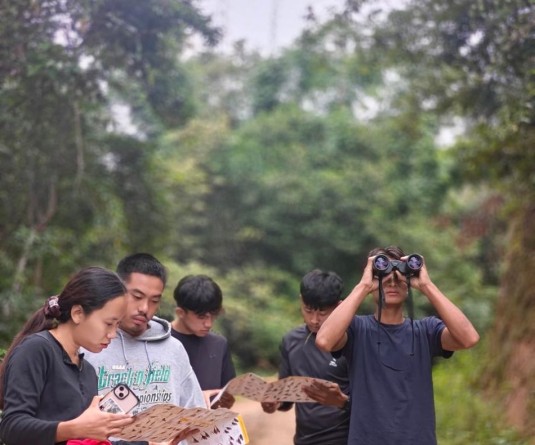
ZD Bon Gangmei
Social/national worker
Contextually speaking, the history of Zeliangrong can be defined in two dispensations; pre-Zeliangrong and post-Zeliangrong. Prior to the creation of Zeliangrong, the cognate tribes were separately identified among themselves as Zeme, Liangmai, and Rongmei & Inpui when outsiders called them as Kacha Naga and Kabui Naga. When in 15th February 1947, the misnamed Kacha and Kabui were denounced openly and collectively renamed as Zeliangrong by Zeme, Liangmai and Rongmei representatives.
Traditionally, oral history tells that the Zeliangrong people in distant past practiced migration or shifting from one place to another in search of good and better land within their compact land. There was no ancient boundary or jurisdiction such as Zeme, Liangmai or Rongmei& Inpui’s land except individual and clans’ land ownership system was practiced. Many Rongmeis migrated from Mbeikamning (present Jalukie areas and Beisumpui Kabei areas) Nkio, Ngam, Njau Ntu etc of present Nagaland to places such as Tamenglong Village, Dailong village, Chiulon Village, Chaengdai village in Tamenglong District. For instance, Benreu Village (Upper Aben) is said to have migrated from Aben of Tausem areas of Present Tamenglong District. The exact record and date of migration could not be ascertained due to lack of literary knowledge and ignorance of historical importance. The fact tells that the Zeliangrong people are a close brotherly related tribal people. The Zeliangrong Clan, culture and traditional practices are originally same and identical among the Zeme, Liangmai and Rongmei. Till date, the original clan of Zeliangrong; Newmai and Pamei are being used as common clan for Zeme, Liangmai and Rongmei subjectively. There still exist in one family, who becomes Zeme, Liangmai and Rongmei in the Zeliangrong society. Therefore the clan they call and their close adherence to each other remain inseparable. There is no indigenous or non indigenous or origin or outsiders within the Zeliangrong country. The imposed arbitrary state boundary should not and cannot separate, segregate or distinguish the three brothers in our own home land. On the day he or she become members of the Zeliangrong Village, he automatically become members and family citizen of the village without any distinction by mean of birth place, descent or origin. Any Zeliangrong villager be it Zeme or Liangmai or Rongmei Village are prohibited to call or address each other as alien, visitor or sojourner on the basis of who come first or later. This declaration is the traditional practice and custom of the head/founder ( Rampeu/Rampou) of the village. He would pronounce or proclaim vocally and affirm that no one should in any manner discriminate the members against the order of the Village. It is Gena to deny or reject ones’ own brother in the land.
History bears witness that, the brotherhood of Zeme, Liangmai, and Rongmei had committed an act of reconciliation to end the era of head hunting, Village feud, and not to shed blood of brothers any more. Whosoever dishonour the solemn ritual performed by violating the same shall suffer the death of the cut cat sacrificed in the ritual act committed on the 1st April 1934 at Tamenglong. Since then, the reunion of Zeliangrong brotherhood started to permeate in the mind and blood vessel of the Zeme, Liangmai, and Rongmei far and wide. When in February 15th 1947, a great coming together of Zeme, Liangmai and Rongmei & Inpui took place at keisamthong Imphal. From that day on, the oneness and solidarity of the three brothers was reaffirmed and constituted as one great Zeliangrong family.
At the tide and turn of 1960s, when the statehood of Nagaland was to curve out of parts of Zeliangrong land by dissecting the compact Zeliangrong geographical landscape for the purpose of creation of the Nagaland state, the Zeliangrong land was divided by arbitrary state boundary without their knowledge and consent. The Zeliangrong people stood true to the cause of the Naga Nation and rejected to part their land to be under Indian state. However, some parts of the Zeliangrong land falls under the present state of Nagaland wherein the Zeme, Liangmai and Rongmei brothers dwells in unison as one people no matter what the division had defined us.
In the process of political change and climate, differences among us gradually shaped to appear distinct as different tribe from the perspective of Indian political system of social classification. Therefore the bond of Zeliangrong was apparently broken at the partial recognition of Zeliangrong in the state of Nagaland as Zeliang. The deprived Rongmeis of Zeliangrong could not raise their voice as they were menorised and cornered. The truth and sense of kindred and universal brotherhood was fading in the hearts of the Zeliangrong people. The seeds of dissension among the Zeliangrongs began since the time of partial recognition. However many true leaders of Zeme, and Liangmai worked hard to reunite the Zeliangrong by creating hope for the disappointed Rongmei brothers. Their Noble feelings and action to restore the bond of brotherhood and unity is vividly remembered, honoured and respected.




